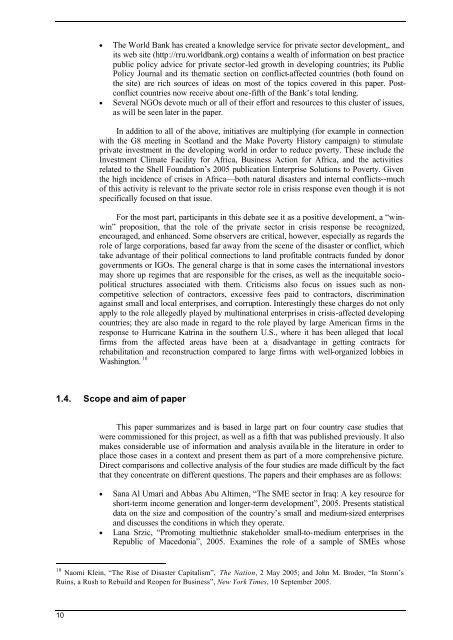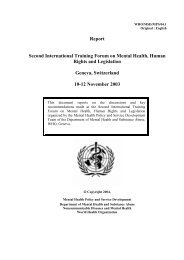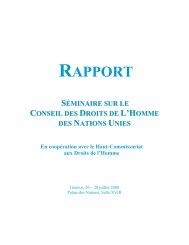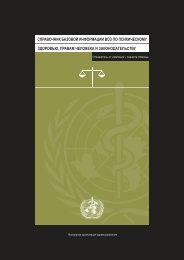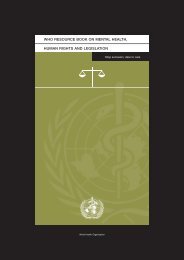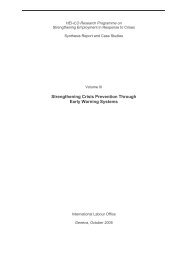Volume 1 Cedric - revised luca Final - RUIG-GIAN
Volume 1 Cedric - revised luca Final - RUIG-GIAN
Volume 1 Cedric - revised luca Final - RUIG-GIAN
Create successful ePaper yourself
Turn your PDF publications into a flip-book with our unique Google optimized e-Paper software.
• The World Bank has created a knowledge service for private sector development,, andits web site (http://rru.worldbank.org) contains a wealth of information on best practicepublic policy advice for private sector-led growth in developing countries; its PublicPolicy Journal and its thematic section on conflict-affected countries (both found onthe site) are rich sources of ideas on most of the topics covered in this paper. Postconflictcountries now receive about one-fifth of the Bank’s total lending.• Several NGOs devote much or all of their effort and resources to this cluster of issues,as will be seen later in the paper.In addition to all of the above, initiatives are multiplying (for example in connectionwith the G8 meeting in Scotland and the Make Poverty History campaign) to stimulateprivate investment in the developing world in order to reduce poverty. These include theInvestment Climate Facility for Africa, Business Action for Africa, and the activitiesrelated to the Shell Foundation’s 2005 publication Enterprise Solutions to Poverty. Giventhe high incidence of crises in Africa—both natural disasters and internal conflicts--muchof this activity is relevant to the private sector role in crisis response even though it is notspecifically focused on that issue.For the most part, participants in this debate see it as a positive development, a “winwin”proposition, that the role of the private sector in crisis response be recognized,encouraged, and enhanced. Some observers are critical, however, especially as regards therole of large corporations, based far away from the scene of the disaster or conflict, whichtake advantage of their political connections to land profitable contracts funded by donorgovernments or IGOs. The general charge is that in some cases the international investorsmay shore up regimes that are responsible for the crises, as well as the inequitable sociopoliticalstructures associated with them. Criticisms also focus on issues such as noncompetitiveselection of contractors, excessive fees paid to contractors, discriminationagainst small and local enterprises, and corruption. Interestingly these charges do not onlyapply to the role allegedly played by multinational enterprises in crisis-affected developingcountries; they are also made in regard to the role played by large American firms in theresponse to Hurricane Katrina in the southern U.S., where it has been alleged that localfirms from the affected areas have been at a disadvantage in getting contracts forrehabilitation and reconstruction compared to large firms with well-organized lobbies inWashington. 101.4. Scope and aim of paperThis paper summarizes and is based in large part on four country case studies thatwere commissioned for this project, as well as a fifth that was published previously. It alsomakes considerable use of information and analysis availa ble in the literature in order toplace those cases in a context and present them as part of a more comprehensive picture.Direct comparisons and collective analysis of the four studies are made difficult by the factthat they concentrate on different questions. The papers and their emphases are as follows:• Sana Al Umari and Abbas Abu Altimen, “The SME sector in Iraq: A key resource forshort-term income generation and longer-term development”, 2005. Presents statisticaldata on the size and composition of the country’s small and medium-sized enterprisesand discusses the conditions in which they operate.• Lana Srzic, “Promoting multiethnic stakeholder small-to-medium enterprises in theRepublic of Macedonia”, 2005. Examines the role of a sample of SMEs whose10 Naomi Klein, “The Rise of Disaster Capitalism”, The Nation, 2 May 2005; and John M. Broder, “In Storm’sRuins, a Rush to Rebuild and Reopen for Business”, New York Times, 10 September 2005.10


